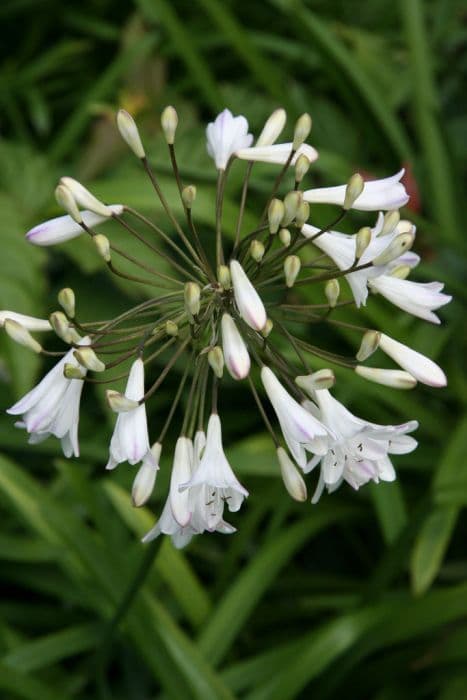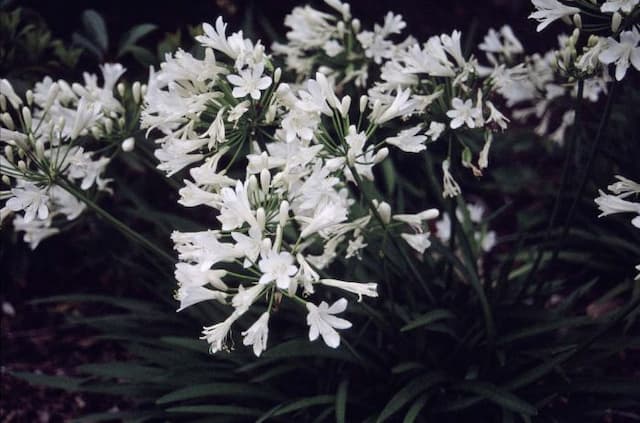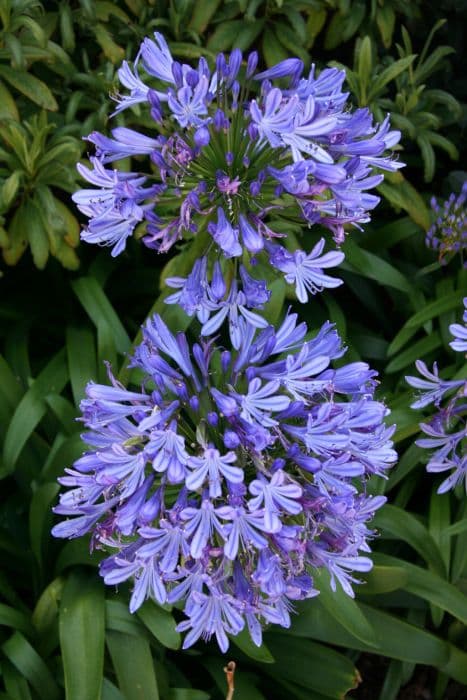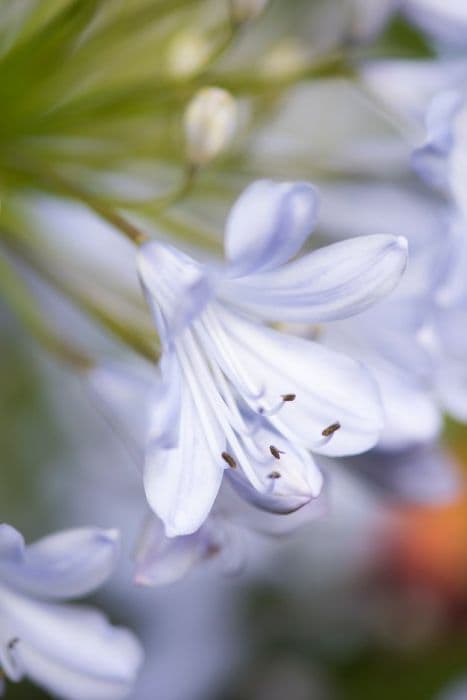African Lily Agapanthus 'African Skies'

ABOUT
Agapanthus 'African Skies' is an ornamental plant known for its striking appearance. It features lush, strap-like foliage that emanates from the base in a graceful, arching fashion. These green leaves form a dense clump, providing a rich backdrop for the plant's signature feature: the blooms. The flowers appear atop long, slender stalks that rise elegantly above the foliage. These blooms cluster into rounded umbels, resembling bursts of sky-blue fireworks. Each trumpet-shaped flower is a delicate shade of blue, transitioning to a paler hue near the edges with a darker stripe running along the center of each petal. The overall visual effect of Agapanthus 'African Skies' is one of cool, serene beauty, as if capturing the calm expanse of the sky in plant form.
About this plant
 Names
NamesSynonyms
African Lily, Lily-of-the-Nile, African Blue Lily
Common names
Agapanthus 'African Skies'
 Toxicity
ToxicityTo humans
Lily of the Nile is not considered highly toxic to humans, but it does contain compounds that can cause unpleasant symptoms if ingested. These may include gastrointestinal discomfort such as nausea, vomiting, and diarrhea. Ingesting large quantities could potentially lead to more severe symptoms, but generally, the plant is not life-threatening to humans.
To pets
Lily of the Nile can be toxic to pets, especially cats and dogs, if ingested. It contains substances that can cause symptoms such as nausea, vomiting, and diarrhea. In some cases, more severe reactions could occur, including tremors or an allergic dermatitis in animals with sensitive skin. Pet owners should therefore prevent their animals from ingesting this plant to avoid the risk of poisoning.
 Characteristics
CharacteristicsLife cycle
Perennials
Foliage type
Evergreen
Color of leaves
Green
Flower color
Blue
Height
2 feet [60 cm]
Spread
2 feet [60 cm]
Plant type
Bulb
Hardiness zones
8
Native area
South Africa
Benefits
 General Benefits
General Benefits- Attractive Flowers: Produces beautiful blue or purple flowers which are aesthetically pleasing and can enhance garden beauty.
- Drought Tolerant: Once established, the plant is relatively drought resistant, requiring minimal watering.
- Low Maintenance: Requires little care beyond basic watering and occasional feeding, making it suitable for busy gardeners.
- Attracts Wildlife: The flowers attract bees, butterflies, and other pollinators, supporting biodiversity in the garden.
- Border Planting: Ideal for use in borders due to its clumping growth habit and striking flowers.
- Long Blooming Period: Offers a long-lasting bloom time from late spring through summer, providing consistent color in the garden.
- Container Gardening: Well-suited to pots and containers, allowing for versatility in garden design and space utilization.
- Tolerant of Various Soil Types: Adapts to a range of soil conditions, although it prefers well-drained soils.
- Perennial Lifespan: As a perennial, it will return year after year, reducing the need to replant annually.
- Deer Resistant: Generally not preferred by deer, which helps prevent damage to the plant in areas with deer presence.
- Erosion Control: The root system can help stabilize soil and prevent erosion on slopes or banks.
 Medical Properties
Medical PropertiesThis plant is not used for medical purposes.
 Air-purifying Qualities
Air-purifying QualitiesThis plant is not specifically known for air purifying qualities.
 Other Uses
Other Uses- The long, sturdy stems of Agapanthus can be used in basket weaving and as natural fibers to create decorative items.
- Agapanthus flowers can be pressed and used in artful compositions such as bookmarks, greeting cards, or framed botanical art.
- The sap from Agapanthus can be used as a mild glue for crafting projects, particularly those involving natural materials.
- Leaves of Agapanthus plants can serve as a green dye source for fabrics or paper when processed correctly.
- Agapanthus flowers may be used as a natural confetti in outdoor celebrations, as they are biodegradable and add a splash of color.
- Dried Agapanthus seed heads add an exotic touch to dry floral arrangements, providing structure and visual interest.
- When grown in outdoor planters, Agapanthus can act as a privacy screen on patios or balconies during the blooming season.
- Agapanthus can be used as a living mulch, as their dense foliage can help suppress weeds around other garden plants.
- The roots of Agapanthus can be used in the treatment of wastewater for the removal of heavy metals, in a process known as phytoremediation.
- Agapanthus 'African Skies' can serve as a marker plant in gardens, to indicate soil moisture levels by observing the droopiness of its leaves.
Interesting Facts
 Feng Shui
Feng ShuiThe Agapanthus is not used in Feng Shui practice.
 Zodiac Sign Compitability
Zodiac Sign CompitabilityThe Agapanthus is not used in astrology practice.
 Plant Symbolism
Plant Symbolism- Love Letters: Agapanthus is often associated with love letters or messages, as its name is derived from the Greek words 'agape' meaning love, and 'anthos' meaning flower.
- Beauty: The striking blue or purple flowers of the agapanthus symbolize beauty and attention to aesthetics.
- Enduring Love: Due to its hardy nature and ability to thrive in various conditions, the agapanthus can represent a love that endures over time and challenges.
- Fertility: The prolific blooms of the plant are sometimes seen as a symbol of fertility and abundance.
- Friendship: Their lush, full blooms can be suggestive of the richness of human relationships, making them representative of friendship.
 Water
WaterAfrican Lily, or Agapanthus 'African Skies', should be watered deeply to encourage root growth, but it must be allowed to dry out slightly between waterings. Typically, watering once a week with about one gallon of water per plant should be sufficient, although this may vary depending on climate and soil conditions. During the active growth season in spring and summer, you may need to water more frequently, especially if the weather is particularly hot or dry. When flowering, consistent moisture is important, but always take care not to overwater as this can lead to root rot. Decrease watering in the fall and water sparingly in winter when the plant is dormant.
 Light
LightAfrican Lily thrives in full sun to partial shade. The ideal spot for the African Lily would be a place where it can receive at least six hours of direct sunlight daily. However, in regions with very intense sun, some afternoon shade will help to prevent leaf scorch. The more light the African Lily receives, the more it will reward you with vibrant blooms.
 Temperature
TemperatureAfrican Lily prefers moderate temperatures and performs best in ranges between 60 and 75 degrees Fahrenheit. It can survive in temperatures as low as 50 degrees Fahrenheit, but growth will be limited. It is not frost-tolerant and should be protected or moved indoors if temperatures are expected to drop below this point. In hot climates, it can handle temperatures up to about 90 degrees Fahrenheit without stress, provided it is well-watered.
 Pruning
PruningThe African Lily benefits from pruning to remove spent flower stalks and encourage more blooms. Prune after flowering by cutting the flower stalks back to the base. This helps to redirect energy to the roots for next year's growth. Pruning can be done annually, and the best time to prune is late summer or early fall after the blooming period is over.
 Cleaning
CleaningAs needed
 Soil
SoilThe Lily of the Nile thrives in a well-draining soil mix with loamy or sandy textures. A good mix could consist of two parts loam, one part sand or perlite, and one part compost or well-rotted manure to enrich the soil. This plant prefers a soil pH that is slightly acidic to neutral, ranging from 6.0 to 7.0.
 Repotting
RepottingLily of the Nile should be repotted every 2 to 3 years to rejuvenate the soil and address root crowding. It is often best done in the spring before the growing season begins. If the plant is not outgrowing its container, top-dressing with fresh soil may suffice.
 Humidity & Misting
Humidity & MistingLily of the Nile does well in average humidity conditions typical of outdoor environments. This plant does not require high humidity and can tolerate the dry air found in most home settings without any special humidity adjustments.
 Suitable locations
Suitable locationsIndoor
Place Lily of the Nile in bright, indirect light, water regularly.
Outdoor
Plant in full sun, ensure soil drains well, protect in winter.
Hardiness zone
8-10 USDA
 Life cycle
Life cycleThe African Lily 'African Skies' begins its cycle with seed germination, which occurs when soil temperatures are warm and after a period of stratification to break dormancy. Seedlings develop, forming a rosette of strap-shaped leaves as they mature into young plants. As the plant grows, it establishes a thick rhizome, which serves as an energy reserve and can give rise to additional shoots or "pups." During spring and summer, it produces tall flower stalks topped with clusters of blue or blue-purple trumpet-shaped flowers. After the flowering period, seed pods may form, containing numerous seeds that can disperse to produce new plants. The African Lily then enters a period of dormancy during colder months, with foliage dying back if exposed to frost, before resurging in the following growing season.
 Propogation
PropogationPropogation time
Spring-Early Summer
Agapanthus 'African Skies', commonly known as Lily of the Nile, is typically propagated by division. The best time to propagate this plant is in the spring or early summer when the plant begins to emerge from dormancy and can recover from the process during the active growing season. To divide Lily of the Nile, carefully dig up the clump after the plant has finished flowering and the foliage has begun to die back. Use a sharp knife or spade to separate the clump into smaller sections, making sure that each section contains at least one or two growing points. These divisions can then be replanted at the same depth they were previously growing, spaced about 12 to 18 inches (approx. 30 to 45 cm) apart to allow for ample growth. Water the new divisions thoroughly after planting to help establish them.









